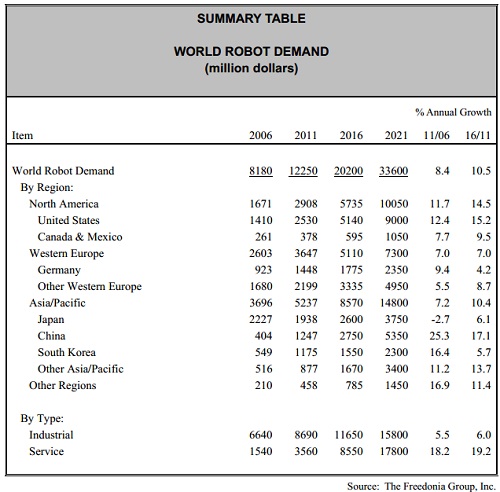Global demand for robots is forecast to increase nearly 11% per year through 2016 to $20.2 billion, outpacing both the world’s economy and overall manufacturing activity. The United States is projected to grow at more than 15% per year in that time, second only to China’s 17% These are among the results of a report from industry market research firm Freedonia Group.
In a recent interview with Modern, senior industry researcher Anand Mehta elaborated on the story behind the numbers. Mehta researched and wrote the report, titled World Robots: Predictions to 2016 and 2021. Robots have come in and out of fashion over the decades, but Mehta said the current boom feels substantially different than the peaks and valleys of past robotic adoption.
“The growth is fast, it’s fast everywhere, and it is in fact faster than almost all of the other product segments Freedonia researches,” said Mehta. “The market is not mature, even in developed countries, so there is lots of potential.”
Mehta attributed the growth to several key advancements in robotic technology. Chief among them is the robustness of related software offerings, as well as increased weight capacities and improved dexterity. He said he expected to see expansion of robots into new applications and improved versions of currently successful technologies.
As robots penetrate further into manufacturing, Mehta said there might soon be a tipping point where robots are almost entirely responsible for making themselves.
More from the report summary:
The world robot market is segmented into two broad categories: industrial robots and service robots. The industrial sector has been a significant user of robots for a few decades now, while the service sector has only become significant since the middle of the first decade of the 2000s. Through 2016 and beyond, service robots will lead growth as lower costs and the increasing sophistication of robot technology and software make these products more appealing to a broader range of consumers.
The robust outlook for service robot demand is leading an increasing number of companies to enter the market, especially in the medical and consumer product sectors, and this should increase competition and further lower costs. Professional applications will continue to dominate the service robot market, with medical robots leading gains, particularly in developed countries.
Five countries—the US, Japan, Germany, China, and South Korea—combined to account for 68 percent of the $12.3 billion global robot market in 2011 and will continue to dominate the overall market through the next decade. The US will remain the largest national market. China will become the second largest market by 2016.
Global robot production is dominated by Japan, the US, Germany, and South Korea, which combined accounted for 70 percent of the total in 2011. Because production is so concentrated, trade is quite important in the robot industry. Sophisticated high-value industrial and medical robots tend to be produced in highly developed countries with established high tech manufacturing industries, such as Japan, the US, and Germany. Smaller, less expensive service robots, especially those geared to the consumer market, are generally produced in countries with developed consumer electronics manufacturing capacity, primarily in Asia.
Of the four largest robot producers in the world, all except the US are net exporters. Japan has the largest trade surplus of robots in the world. The country was an early developer and adopter of robotics technology and has been at the forefront of expanding robot applications worldwide. Most other countries run trade deficits in robots, especially countries with less developed high tech manufacturing sectors. China is the world’s largest net importer of robots, although the country runs a large trade surplus in robotic vacuum cleaners. While China’s production capacity is rapidly increasing, the country is expected to remain a net importer of robots due to technology limitations as well as the massive amount of equipment required to upgrade the country’s manufacturing infrastructure.
The industrial robot market is concentrated, with the top dozen suppliers together accounting for more than two-thirds of global sales. ABB and FANUC are by far the leading producers, followed by Yaskawa Electric, KUKA, and Kawasaki Heavy Industries. The service robot market is currently led by Intuitive Surgical, iRobot and Lely, and DeLaval, the leading producers of medical robots, floor cleaning robots, and milking robots, respectively.
Industrial robots are used for a variety of functions, including handling, welding (which includes soldering), assembly and disassembly, cleanroom operations, dispensing (which includes painting), and processing. However, handling and welding applications dominate. In 2011, handling applications accounted for 40 percent of industrial robot demand, while welding applications accounted for around 30 percent. Within the handling arena, the conveying of products through the assembly line is an important operation, especially in the automotive sector.
Other significant handling operations include packaging, pelletizing, picking, placing, and plastic molding. The food and beverage and pharmaceutical industries are increasingly using robots to automate packaging. In the semiconductor industry, robots are seeing more usage for picking and placing sensitive items. Welding robots predominantly consist of two product types: arc welding robots and spot welding robots. The latter are primarily used in the automotive industry, while the former are used in both the automotive and metal industries.
Other niche welding robot types include gas welders, laser welders, plasma welders, and ultrasonic welders. Assembly robots are mainly used in the electrical/electronics industry, with the automotive parts manufacturing industry also a significant user. Cleanroom robots see the most use in the electronics industry, so their market is heavily dominated by five countries: South Korea, Japan, the US, China, and Taiwan.






